- Home
- About
- Map
- Trips
- Bringing Boat West
- Migration West
- Solo Motorcycle Ride
- Final Family XC Trip
- Colorado Rockies
- Graduates' XC Trip
- Yosemite & Nevada
- Colorado & Utah
- Best of Utah
- Southern Loop
- Pacific Northwest
- Northern Loop
- Los Angeles to NYC
- East Coast Trips
- 1 Week in Quebec
- Southeast Coast
- NH Backpacking
- Martha's Vineyard
- Canadian Maritimes
- Ocracoke Island
- Edisto Island
- First Landing '02
- Hunting Island '02
- Stowe in Winter
- Hunting Island '01
- Lake Placid
- Chesapeake
- Provincetown
- Hunting Island '00
- Acadia in Winter
- Boston Suburbs
- Niagara Falls
- First Landing '99
- Cape Hatteras
- West Coast Trips
- Maui
- Mojave 4WD Course
- Colorado River Rafting
- Bishop & Death Valley
- Kauai
- Yosemite Fall
- Utah Off-Road
- Lost Coast
- Yosemite Valley
- Arizona and New Mexico
- Pescadero & Capitola
- Bishop & Death Valley
- San Diego, Anza Borrego, Joshua Tree
- Carmel
- Death Valley in Fall
- Yosemite in the Fall
- Pacific Northwest
- Utah Off-Roading
- Southern CA Deserts
- Yosemite & Covid
- Lake Powell Covid
- Eastern Sierra & Covid
- Bishop & Death Valley
- Central & SE Oregon
- Mojave Road
- Eastern Sierra
- Trinity Alps
- Tuolumne Meadows
- Lake Powell Boating
- Eastern Sierra
- Yosemite Winter
- Hawaii
- 4WD Eastern Sierra
- 4WD Death Valley +
- Southern CA Deserts
- Christmas in Tahoe
- Yosemite & Pinnacles
- Totality
- Yosemite & Sierra
- Yosemite Christmas
- Yosemite, San Diego
- Yosemite & North CA
- Seattle to Sierra
- Southwest Deserts
- Yosemite & Sierra
- Pacific Northwest
- Yosemite & South CA
- Pacific Northwest
- Northern California
- Southern Alaska
- Vancouver Island
- International Trips
- Index
- Tips
- Books
- Photos/Videos
- Search
- Contact
Fallingwater
Tuesday, August 2, 2005 - 6:30am by Lolo300 miles and 6 hours from our last stop
Travelogue
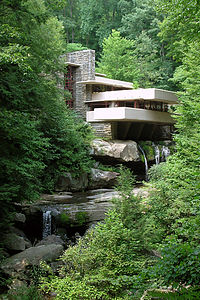 FallingwaterAs we continued our journey east, Herb asked the question that he always seems to ask when we enter Pennsylvania--"Why haven't we been to Fallingwater?" He followed this question with an accusatory look, implying that I am somehow to blame for this void in his travel experiences. Since I'm the one that plans the trips, I guess he had a point. I quickly looked through the piles of guidebooks we had along, but couldn't find anything about it--it's times like these that I really wish we had Internet access in the RV. However, since we didn't, I did the next best thing. I called a friend back home and got information on tours and most importantly, a phone number for reservations. Fortunately, we were able to book a tour for later that afternoon.
FallingwaterAs we continued our journey east, Herb asked the question that he always seems to ask when we enter Pennsylvania--"Why haven't we been to Fallingwater?" He followed this question with an accusatory look, implying that I am somehow to blame for this void in his travel experiences. Since I'm the one that plans the trips, I guess he had a point. I quickly looked through the piles of guidebooks we had along, but couldn't find anything about it--it's times like these that I really wish we had Internet access in the RV. However, since we didn't, I did the next best thing. I called a friend back home and got information on tours and most importantly, a phone number for reservations. Fortunately, we were able to book a tour for later that afternoon.
For those not familiar with Fallingwater, it's Frank Lloyd Wright's famous house built on top of a waterfall. The house was built for the Edgar J. Kaufmann family (of Kaufmann furniture fame) back in the 1930s. Members of the family lived in it until the 1960s, after which it was given to the Western Pennsylvania Conservancy to maintain and manage. Today it is open to the public for tours, and it is definitely well worth it.
We arrived about an hour early for our tour, so we spent the time wandering the lovely grounds over towards the viewpoint of the house below the waterfall. Unfortunately, photographing the house wasn't as good as we had hoped. The waterfall over which the house was built was barely flowing because of the summer-long drought that had hit most of the east coast, and there were workmen clambering about on ladders along the upper terraces smack in the middle of our pictures. So like all photos must, we captured the reality of the moment--or at least, that's how things used to work. We might have captured workmen on ladders, but Herb made them disappear with the wonderful technology of Photoshop. Unfortunately, he couldn't do much about the waterfall. That would be too much cheating.
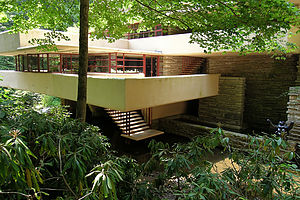 FallingwaterFallingwater was truly unique. The most notable feature was a series of cantilevered balconies protruding from every side and level of the house. Since there was no visible support, they seemed to just magically extend from the walls of the house. Frank Lloyd Wright believed in organic design, which meant that he wanted the structure to blend in and be a part of its surrounding environment. To accomplish this he used sandstone quarried right on the property so that it matched perfectly with the surrounding stone. Also the horizontal ledges of the balconies mimicked the rock ledges behind it. It reminded me of the way that some of the best National Park lodges (like Yellowstone, the North Rim of the Grand Canyon, and the Awahnee in Yosemite) also seem to be extensions of their surroundings rather than intrusions on it.
FallingwaterFallingwater was truly unique. The most notable feature was a series of cantilevered balconies protruding from every side and level of the house. Since there was no visible support, they seemed to just magically extend from the walls of the house. Frank Lloyd Wright believed in organic design, which meant that he wanted the structure to blend in and be a part of its surrounding environment. To accomplish this he used sandstone quarried right on the property so that it matched perfectly with the surrounding stone. Also the horizontal ledges of the balconies mimicked the rock ledges behind it. It reminded me of the way that some of the best National Park lodges (like Yellowstone, the North Rim of the Grand Canyon, and the Awahnee in Yosemite) also seem to be extensions of their surroundings rather than intrusions on it.
When the time came for our house tour, we were escorted by our very pleasant and knowledgeable tour guide into the home along with about 12 others--a very reasonably-sized group. Herb had to reluctantly part with his video camera at the entrance as no photography, either still or video, is allowed on this tour. There is another more in-depth 2-hour tour that does allow still photography.
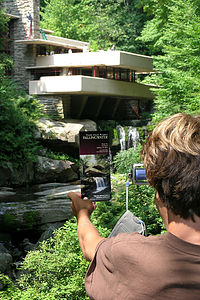 Tommy photographing FallingwaterWe immediately fell in love with the interior of the house, which didn't really feel like an interior at all, but rather, once again, an extension of the rocks and woods around it. The colors in the house were all earth tones. The floors were made of polished stone, like the stone surrounding the house. The hearth of the large fireplace in the living room was actually a boulder which protruded into the house. Most of the walls to the outside were made up of large casement windows so that there was always a great view outside. Also, every room lead out onto one of the large cantilevered balconies so there was always easy access to the outdoors. My personal favorite was the staircase leading down from the living room to a small platform on the stream, from which you could take a dip in the very cool waters. Everything about this house was a nature lover's paradise. It must have been an amazing opportunity for the Kaufmann's to have lived in it.
Tommy photographing FallingwaterWe immediately fell in love with the interior of the house, which didn't really feel like an interior at all, but rather, once again, an extension of the rocks and woods around it. The colors in the house were all earth tones. The floors were made of polished stone, like the stone surrounding the house. The hearth of the large fireplace in the living room was actually a boulder which protruded into the house. Most of the walls to the outside were made up of large casement windows so that there was always a great view outside. Also, every room lead out onto one of the large cantilevered balconies so there was always easy access to the outdoors. My personal favorite was the staircase leading down from the living room to a small platform on the stream, from which you could take a dip in the very cool waters. Everything about this house was a nature lover's paradise. It must have been an amazing opportunity for the Kaufmann's to have lived in it.
Before leaving, we stopped in the gift shop to see if we could get a hat pin to add to our collection. We soon found that this was no mere tacky gift shop, but an impressive museum shop filled with collectibles relating to Frank Lloyd Wright or Fallingwater in some way. There were beautiful lamps, dishes, clocks, furnishings, jewelry, etc. There wasn't a snow globe to be found.
Our last highlight at Fallingwater was found in the restrooms. As we sat on the benches outside the museum shop, a noise very much like that of a jet engine would periodically emanate from the restroom, followed by a person walking out of the door. After this pattern repeated itself about half a dozen times, the boys just had to have a look-see. What they discovered inside was a very powerful, turbo-charged hand dryer that actually dried your hands without having to wipe them on your pant legs. During their absence, Herb and I heard the roar of the jet engines going off again and again and again with no one exiting in between. Gee, I wonder why.
Description
Frank Lloyd Wright's Fallingwater is one of the most famous works of architecture in the United States. Wright designed it in 1935 as a vacation home for the Edgar J. Kaufmann family. In designing their home, Wright tried to satisfy the Kaufmann family's love of nature by building the house directly over the waterfall and stream on their property in Mill Creek, Pennsylvania. It is a masterpiece of modern architecture and a symbol of the importance of living in harmony with the natural world.
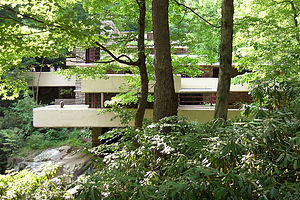 FallingwaterFrank Lloyd Wright is considered one of the greatest architects of the 20th century. However, his unique and non-traditional style, which you can see in the design of Fallingwater, also made him one of the most controversial. Wright believed that a building should not be a static structure, but rather a dynamic one that relates to its natural surroundings. This principle, which is known as organic architecture, tries to promote the harmony between man and nature by having the building and its furnishings blend in with its surroundings.
FallingwaterFrank Lloyd Wright is considered one of the greatest architects of the 20th century. However, his unique and non-traditional style, which you can see in the design of Fallingwater, also made him one of the most controversial. Wright believed that a building should not be a static structure, but rather a dynamic one that relates to its natural surroundings. This principle, which is known as organic architecture, tries to promote the harmony between man and nature by having the building and its furnishings blend in with its surroundings.
Fallingwater not only blends in, but it almost seems to mimic its surroundings. The series of horizontal balconies protruding from it appear to be extensions of the rock ledges around it. Also the materials from which the walls were constructed were Pottsville sandstone quarried right on the property. This was the same type of sandstone as the rock ledges surrounding the house, making it blend in even more perfectly.
Interestingly, the balconies seemed to just magically extend unsupported from the walls of the house, like a series of trays. Wanting to avoid vertical supports, Wright used a technique known as cantilevering, in which the balconies were only supported on one end--the wall of the house. There are several of these balconies at different levels and orientations, providing almost as much floor space as the interior of the house.
Even the interior of the house blends in with its surroundings. The colors in the house, in keeping with the nature theme, are all earth tones. The floors are all made of polished stone, like the stone surrounding the house. The hearth of the large fireplace in the living room is actually a boulder which protrudes into the house. Unlike the high ceilings found in many impressive homes, Wright kept the ceilings of Fallingwater low so that your eyes would be guided outside towards nature rather than up. Most of the walls to the outside are made up of large casement windows so that there is always a great view outside. Also, every room has one of the large cantilevered balconies off of it so that it is easy to have access to the outdoors. There is even a staircase leading down from the living room to a small platform on the stream from which you could take a dip in its cool waters.
In 1963, Edgar Kaufmann, Jr. gave the house to the Western Pennsylvania Conservancy under the condition that they preserve it and open it for public visitation. Today, tours are available on Tuesdays - Sundays from mid-March through Thanksgiving. The most popular tour is the regular tour, which lasts approximately one hour and includes all of the major rooms of the house. Ticket prices are: Weekdays: Adults $13.00, youth 6-18 $ 8.00 and Weekends: Adults $15.00, youth 6-18 $10.00. For more detailed information on all their tours and to make advance reservations, go to www.paconserv.org.
Brookville - KOA
Monday, August 1, 2005 - 12:00pm by Lolo343 miles and 6.5 hours from our last stop - 1 night stay
Travelogue
Every Ohio campground we have ever stopped in has been top notch, and this one was no exception. Unfortunately, we got there so late in the day that there was barely time to enjoy its many facilities. However, we decided to give it a try.
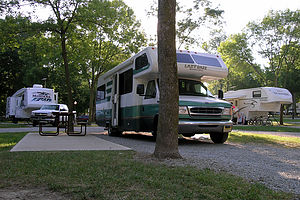 Brookville KOA campsiteThe boys and I started off with a round of mini-golf, followed by a dip in the pool, and then ended with Herb and Tom fishing in the pond while Andrew went for a run. All that was followed by a dinner, which didn't get eaten until after 9:00. It was like one last frantic effort to squeeze more fun into the last remaining days of our trip.
Brookville KOA campsiteThe boys and I started off with a round of mini-golf, followed by a dip in the pool, and then ended with Herb and Tom fishing in the pond while Andrew went for a run. All that was followed by a dinner, which didn't get eaten until after 9:00. It was like one last frantic effort to squeeze more fun into the last remaining days of our trip.
Tomorrow we would decide whether we were going to make the push for home--in which case this would be our final night--or linger one more day on the road. I was for lingering and selfishly having the boys for one more night to ourselves. I knew that as soon as we hit the driveway, the phone would be ringing, and they would off and running. I wasn't sure if I was ready for that yet.
Description
The Brookville KOA is an award winning 204-site campground just minutes from I70. Within its lovely park-like setting, the campground has a heated 80-foot swimming pool, a fishing pond with paddleboat rentals, and mini-golf.
Gateway Arch / St. Louis
Monday, August 1, 2005 - 7:00am by Lolo82 miles and 1.5 hours from our last stop
Travelogue
The Gateway Arch was a long overdue stop for us. It was the monumental symbol of westward journeys, yet in our own numerous journeys west, we had yet to visit it. I felt inadequate in my role as a traveler. This year's eastward route took us on I70 right through St. Louis, so we decided to finally see it--even if it was our Gateway to the East rather than the West.
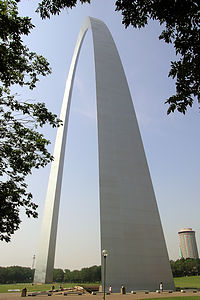 Gateway ArchHerb is never that excited about visiting cities in the motorhome. Parking is often a challenge and maneuvering in and out of traffic can often be nerve racking. However, he too realized that this was something that must be done. Fortunately, we found an area on the street along the Mississippi where several RVs were parked. From there it was just a short walk to the Arch, which was actually part of the 97-acre Jefferson National Expansion Memorial.
Gateway ArchHerb is never that excited about visiting cities in the motorhome. Parking is often a challenge and maneuvering in and out of traffic can often be nerve racking. However, he too realized that this was something that must be done. Fortunately, we found an area on the street along the Mississippi where several RVs were parked. From there it was just a short walk to the Arch, which was actually part of the 97-acre Jefferson National Expansion Memorial.
The Arch was even more impressive than I had imagined. It was huge--630 feet high and 630 feet between its legs. That's over two football fields wide. Its stainless steel glistened in the sunlight. We approached it from the Mississippi River, up an impressive Grand Staircase, as wide as the distance between the legs of the Arch, to its base.
By the southern leg, we found a ramp that led down to an underground visitor center beneath the Arch. The center contained the Museum of Westward Expansion, theaters with interpretive movies on the Arch's construction, a large gift shop, and most importantly the start of the "pod" ride to the top of the Arch. This is what we'd come here for, but when I got my first glance at a pod, I wasn't so sure.
 Family ascending Arch in the PODI'm not a big fan of tightly enclosed spaces, so I admit my palms were a bit sweaty as we waited to board our family pod. Each family (or group of up to 5) was given a number from 1-8 and instructed to stand in front of their pod door, which looked like an elevator door for midgets. I felt like I was in a Jetsons cartoon episode. After a few minutes, we heard the whirring sound of our pod's arrival, the tiny door opened, and current podians disembarked. The pod was actually quite cute and cozy, with 5 seats and a small window from which we could watch the inside of the arch whiz by. In a mere 4 minutes of travel, our pod doors opened, and we were let out into an observation area at the top. The view was quite impressive and it was quite weird to think that we were actually standing in the top of the Arch. There were 16 windows looking east over the Mississippi River and another 16 looking west over the city of St. Louis. My favorite was looking down into the stadium where the St. Louis Cardinals play.
Family ascending Arch in the PODI'm not a big fan of tightly enclosed spaces, so I admit my palms were a bit sweaty as we waited to board our family pod. Each family (or group of up to 5) was given a number from 1-8 and instructed to stand in front of their pod door, which looked like an elevator door for midgets. I felt like I was in a Jetsons cartoon episode. After a few minutes, we heard the whirring sound of our pod's arrival, the tiny door opened, and current podians disembarked. The pod was actually quite cute and cozy, with 5 seats and a small window from which we could watch the inside of the arch whiz by. In a mere 4 minutes of travel, our pod doors opened, and we were let out into an observation area at the top. The view was quite impressive and it was quite weird to think that we were actually standing in the top of the Arch. There were 16 windows looking east over the Mississippi River and another 16 looking west over the city of St. Louis. My favorite was looking down into the stadium where the St. Louis Cardinals play.
After enjoying the view, we got back on the pod line to make our descent. This time when our pod door opened, the largest family I have ever seen in my life exited the pod. There were 5 of them and one large baby. I don't even want to think about what went on during their 4-minute ascent.
Back safely on the ground, we took a quick walk through the Museum of Westward Expansion and then got on our way. We still had a long way to go, and I think that now that the trip was sort of psychologically over, the boys were getting more and more anxious to get home to their friends.
Description
The Gateway Arch is part of the 97-acre Jefferson National Expansion Memorial, which is run by the National Park System. The park was established to celebrate our westward expansion and to honor the man that inspired it--Thomas Jefferson.
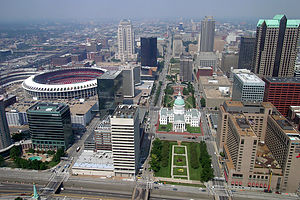 View from top of the ArchThis majestic stainless steel Arch towers 630 feet above the banks of the Mississippi River. The distance between the outer faces of its legs is also 630 feet. Each leg is an equilateral triangle with sides 54 feet long at ground level, tapering to 17 feet at the top. The foundations of the Arch are sunk 60 feet into the ground in order to withstand high winds and earthquakes. In a 20 mph wind, it sways about one inch, but it is built to be able to sway up to 18 inches. A Grand Staircase, as wide as the distance between the legs of the Arch, leads from the Mississippi levee up to its base.
View from top of the ArchThis majestic stainless steel Arch towers 630 feet above the banks of the Mississippi River. The distance between the outer faces of its legs is also 630 feet. Each leg is an equilateral triangle with sides 54 feet long at ground level, tapering to 17 feet at the top. The foundations of the Arch are sunk 60 feet into the ground in order to withstand high winds and earthquakes. In a 20 mph wind, it sways about one inch, but it is built to be able to sway up to 18 inches. A Grand Staircase, as wide as the distance between the legs of the Arch, leads from the Mississippi levee up to its base.
The Gateway Arch was designed in 1947 by Eero Saarinen. It was the winning entry in a national competition to design a monument to represent the spirit of the western pioneers. At 630 feet, it is the tallest monument in the United States. It was completed in 1965 at a total cost of $15 million.
The highlight of a visit to Jefferson National Expansion Memorial is a ride one of the unique tram cars ("or pods") to the top of the 630-foot Gateway Arch, for a panoramic view of the Mississippi River and the city of St. Louis. Each of the 16 "pods" holds 5 people. During the 4-minute journey to the top, passengers can look out the small window for a view of the interior of the Arch. At the top you exit the pod into the observation area, where you can stay as long as you like. The observation area has 16 windows looking east over the Mississippi River and 16 looking west over the city of St. Louis. The cost of the tram ride is $10 for adults ($7 with a National Park Pass), $7 for youths 13-16, and $3 for children 12 and under.
In addition to the Arch, the Jefferson National Expansion Memorial has an underground visitor center directly beneath the Arch. The center contains the Museum of Westward Expansion, as well as theaters with movies on westward expansion and the Arch's construction. The museum has an extensive collection of artifacts, mounted animal specimens, an authentic American Indian tipi, and an overview of the Lewis and Clark expedition.
Spencer Art Museum - University of Kansas
Sunday, July 31, 2005 - 6:00am by Lolo145 miles and 2.5 hours from our last stop
Travelogue
Part way through our trip, Andrew informed us that he had to visit two art museums this summer for his AP Art History course. Not wanting to have to rush around when we got home and desperately wanting to find things to break up our long driving days home, I searched the guidebooks for some ideas. The first one I came up with was the Spencer Art Museum at the University of Kansas in Lawrence. The campus was only a short distance off of I70 so it was hardly out of our way at all.
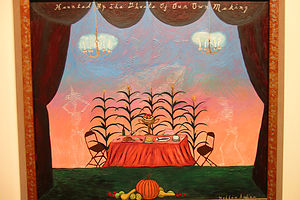 Haunted by the Ghosts of Our Own MakingWe parked in the large campus parking lot on Mississippi Street, right next to the museum. The campus was totally deserted--probably because it was a Sunday in late July--but fortunately the museum was open. Being photography buffs, we were delighted to see the Exhibit banner over the doorway announcing that the "Daguerreotype to Digital" exhibit was going to be there until July 31. That was today! How fortunate. The exhibit, which surveyed the history of photography from the 1840s to the present, was fabulous.
Haunted by the Ghosts of Our Own MakingWe parked in the large campus parking lot on Mississippi Street, right next to the museum. The campus was totally deserted--probably because it was a Sunday in late July--but fortunately the museum was open. Being photography buffs, we were delighted to see the Exhibit banner over the doorway announcing that the "Daguerreotype to Digital" exhibit was going to be there until July 31. That was today! How fortunate. The exhibit, which surveyed the history of photography from the 1840s to the present, was fabulous.
I had to tear Andrew away to concentrate on his AP Art History assignment, which was to select a painting to analyze. We wandered through the various gallery rooms looking for something that struck his interest. In the 20th and 21st century gallery, we were attracted to a brightly colored painting of a table set with food with a sunset colored background. It was entitled "Haunted by the Ghosts of Our Own Making." Upon closer inspection, we noticed that the painting was a lot more than just a pleasant dinner scene. Two barely visible skeletons were serving the food, the letters "DDT" were written faintly above the table, and the frame was covered with scripted writing warning of the dangers of cancer-causing pesticides. We then learned that the artist, Hollis Sigler, was struggling with breast cancer when she made this painting and that she died shortly afterwards. Now that we knew more about its meaning and context, the painting seemed totally different to us than our first impression of it. The boys were starting to really get into it. I love art history, so I was delighted.
As soon as we got back in the RV, I started looking for our next art museum to visit.
Description
The Spencer Art Museum is located at 1301 Mississippi Street, on the northeast corner of the University of Kansas campus in Lawrence. Since the museum is part of the University and serves as a resource for teaching art history, humanities, and fine arts, its collection is quite comprehensive.
There are seven galleries that display selections from the more than 25,000 works of art in the museum's permanent collection. These pieces span the history of European, North American, and East Asian art. Areas of particular strength are medieval art; European and American paintings, sculpture, and prints; photography, Japanese painting and prints; and 20th century Chinese painting.
More than half of the Western paintings and sculpture are on permanent exhibit. The much more numerous Western and Asian prints, drawings, photographs, and the Museum's renowned quilt collection, are shown on a rotating basis in short-term, thematic exhibitions.
Gallery hours are:
Tuesday - Saturday 10 a.m. - 5 p.m.
Sunday Noon - 5 p.m.
Closed on Mondays
Breckenridge
Thursday, July 28, 2005 - 11:00am by Lolo31 miles and 0.75 hours from our last stop - 2 night stay
Travelogue
Breckenridge was a discovery that we had made two years ago on the return leg of another one of our cross country journeys and one that we vowed to come back to if given the chance. The setting of the village is lovely, with its quaint Victorian Main Street, the Blue River running through the heart of it, and snow-covered peaks rising right from its edge. Also, it has a great personality--kind of like Moab--funky and down to earth. Vail might have been just as pretty, but it was a bit too ritzy and ostentatious for our taste. Breckenridge fit us much better.
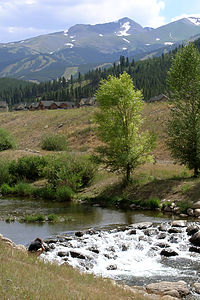 Andrew photographing along the Blue River BikewayAlso, unlike Vail, Breckenridge has a campground (the Tiger Run RV Resort), and what a campground it is. It's more like RV land for the rich and famous, with million dollar RVs as far as the eye can see. It was even featured on the Travel Channel as one of the top campgrounds in the county. It definitely was the most beautiful commercial campground we have ever stayed in--although I still do prefer the National Parks. The resort was meticulously maintained. The sites, which were quite spacious, each had a concrete pad surrounded by a manicured lawn, and all of them had views of the snow-capped mountains. Many of the sites were located right along the scenic Blue River. In addition to the nice aesthetics, there were plenty of recreational facilities to entertain guests of all ages. Besides the basketball and tennis courts, there is an incredible 12,000 square foot clubhouse, complete with indoor swimming pool, two hot tubs, game room, TV lounge, and live entertainment on the weekends. It was definitely more like a resort than a campground. In fact, almost all the sites are owned and many of them have more permanent log cabin or chalet type structures on them. One thing we did notice this time though compared to our last visit was that many more of the sites were for sale--probably more than 10% of them. Something must be going on here for so many people to want out. I don't understand it though, because it really is spectacular, and I'm sure that in the winter it's even better being that it is so close to one of the best ski resorts in the country.
Andrew photographing along the Blue River BikewayAlso, unlike Vail, Breckenridge has a campground (the Tiger Run RV Resort), and what a campground it is. It's more like RV land for the rich and famous, with million dollar RVs as far as the eye can see. It was even featured on the Travel Channel as one of the top campgrounds in the county. It definitely was the most beautiful commercial campground we have ever stayed in--although I still do prefer the National Parks. The resort was meticulously maintained. The sites, which were quite spacious, each had a concrete pad surrounded by a manicured lawn, and all of them had views of the snow-capped mountains. Many of the sites were located right along the scenic Blue River. In addition to the nice aesthetics, there were plenty of recreational facilities to entertain guests of all ages. Besides the basketball and tennis courts, there is an incredible 12,000 square foot clubhouse, complete with indoor swimming pool, two hot tubs, game room, TV lounge, and live entertainment on the weekends. It was definitely more like a resort than a campground. In fact, almost all the sites are owned and many of them have more permanent log cabin or chalet type structures on them. One thing we did notice this time though compared to our last visit was that many more of the sites were for sale--probably more than 10% of them. Something must be going on here for so many people to want out. I don't understand it though, because it really is spectacular, and I'm sure that in the winter it's even better being that it is so close to one of the best ski resorts in the country.
 Tiger Run neighbors in an AirstreamFortunately, we were able to get one of the last available sites, and it was right on the river. We were pretty exhausted from our mountain biking at Vail and then the ride down from Vail Pass, so the only activity we were up for that evening was a soak in the hot tub.
Tiger Run neighbors in an AirstreamFortunately, we were able to get one of the last available sites, and it was right on the river. We were pretty exhausted from our mountain biking at Vail and then the ride down from Vail Pass, so the only activity we were up for that evening was a soak in the hot tub.
When we woke up the next morning we decided to book another night at Tiger Run so that we could spend the entire day wandering around Breckenridge. It was Friday, so I was surprised that we were able to get anything for the night, but we did. We just had to move the RV to a different site.
We left the RV at the campground and rode our bikes along the Blue River Bikeway to the village, about 4 miles away. Once in town, we found a place to lock our bikes up and wandered along Main Street browsing in the shops. The boys were in search of a shop we had visited last time that had some really unique rock and reggae t-shirts and other paraphernalia. We weren't sure of the name, but we were sure we would recognize it when we saw it. Sure enough, we found it - The Space Cowboy. The shop felt like a throwback to the 60s. This was my teenage heritage that the kids were mooching in on--Pink Floyd, the Who, the Rolling Stones, and so on and so on. Andrew, especially, is really into classic rock and it's really all he plays. At least it makes picking a radio station to listen to really easy.
 Lolo and boys dining at Fatty's PizzeriaThe owner of Space Cowboy recommended Fatty's Pizzeria as a good place for a lunch, and he was right. We always like to avoid the touristy places and eat at a place that the locals like. The pizza was good and the prices were reasonable.
Lolo and boys dining at Fatty's PizzeriaThe owner of Space Cowboy recommended Fatty's Pizzeria as a good place for a lunch, and he was right. We always like to avoid the touristy places and eat at a place that the locals like. The pizza was good and the prices were reasonable.
The next new discovery was Bubba Gump's, a gift shop specializing in everything related to Forrest Gump. There was even a bench outside with a sculpted suitcase and box of chocolates on it. If you sat on the bench, you could slip your feet into a large pair of sneakers just like the ones Forrest wore when he just ran and ran and ran. I never realized there was so much merchandising from this movie--there were glasses, mugs, kitchen magnets, bumper stickers, shrimp beanie babies, boxes of chocolate (of course), license plates, BBQ sauce, and on and on. We got off easy with a Run Forrest Run t-shirt.
 Lolo and Tommy in the Blue RiverEventually, we found our way back to the lovely riverside park where we had locked our bikes. There were now dozens of people lounging happily on the steps and a few brave souls who had taken off their shoes and were wading in the ankle-deep, frigid water of the Blue River. That looked fun. I finally convinced Tommy to join me in wading out to a copper moose statue standing in the water. It was a lot harder than it looked, and I'm sure I didn't look very graceful slipping and sliding over the slimy rocks to get there. I made Herb take out his camera again to get a picture of us.
Lolo and Tommy in the Blue RiverEventually, we found our way back to the lovely riverside park where we had locked our bikes. There were now dozens of people lounging happily on the steps and a few brave souls who had taken off their shoes and were wading in the ankle-deep, frigid water of the Blue River. That looked fun. I finally convinced Tommy to join me in wading out to a copper moose statue standing in the water. It was a lot harder than it looked, and I'm sure I didn't look very graceful slipping and sliding over the slimy rocks to get there. I made Herb take out his camera again to get a picture of us.
What a great place! Breckenridge has definitely earned a place on our list of all-time favorite towns to visit. I'm sure we'll be back again someday.
Description
Breckenridge is located approximately 75 miles west of Denver in one of the premier skiing areas in the country. Most of the surrounding area is part of the Arapaho National Forest. The town itself is located in the beautiful Blue River Valley at the base of the Ten Mile Range of the Rockies.
Before it became a premier ski resort, Breckenridge was a thriving mining camp. In 1859, when word got out that gold was discovered in the Blue River near current day Breckenridge, hundreds of miners flocked here from Denver and set up a mining camp. In an attempt to get their own post office, the miners named their camp after the current Vice President, John C. Breckinridge (note the difference in spelling). Flattery worked and soon they had their own mail service. When the Civil War began, the town of Breckinridge sided with the South. No longer feeling loyalty to the Federal Government, they changed the spelling of the town to Breckenridge.
In many ways, the village, with its crowded bars and restaurants along its funky main street has maintained that frontier feeling. It was also one of the first ski areas in Colorado to allow snowboarding.
Besides the spectacular skiing, Breckenridge is an outdoor lover's paradise in all four seasons with such adventure highlights as:
- Hiking the many trails in the Arapaho National Forest
- Bicycling the paved Blue River Bikeway along the river between Frisco and Breckenridge
- Biking the 20-mile Vail Pass Bikeway over the 10,600 foot pass into Vail
- Sailing and windsurfing in the Dillon Reservoir just north of Breckenridge
- Fishing for trout and salmon in the Dillon Reservoir
- Fishing for trout in the world-class trout waters of the Blue River
- Rafting the Blue River
- Skateboarding in the outdoor, free skateboard park at the recreation center
- Testing your kayak skills in the man-made rapids section of the Blue River near the recreation center
A few miles north of the town of Breckenridge is the Tiger Run RV Resort, one of the premier RV campgrounds in the country. Most of the sites are owned, but there are some sites available for transients. Some of the many amenities include: landscaped sites with patios, a beautiful clubhouse with fireplace, an indoor pool and hot tub, and lake and stream fishing.
Arches National Park
Tuesday, July 26, 2005 - 3:00am by Lolo23 miles and 0.5 hours from our last stop - 1 night stay
Travelogue
We left Moab early, hoping to get one of the highly coveted campsites in Devils Garden, Arches only campground. Since the campground works on a first-come-first-serve basis and there are only 52 sites, we knew that if we didn't get their early, we would be disappointed again as we had been the day before. Fortunately, there were a few sites left. However, the rule is that they'll hold the site for you until noon, but if you haven't claimed it by then, you forfeit it. Since the campground is located at the very end of the 17-mile scenic drive, this didn't leave us too much time for sightseeing along the way. Fortunately, we had been to Arches twice before and pretty much had seen all there was to see along the drive, so we didn't feel too bad whizzing by what were some truly incredible sights. We did make a brief stop though at one of our old favorites--Double Arch, where we took the short hike from the parking lot and scrambled up the rocks to a ledge right underneath the arch.
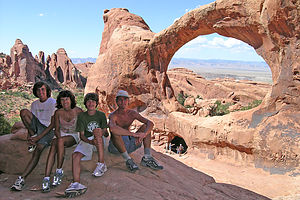 Family Portrait at Double O ArchNot wanting to risk losing our campsite, we continued on, driving right past the beautiful fiery furnace section along the way. At the end of the drive, we circled through the campground looking on each site's post for the little smiley face that indicated that it was available. Where the heck were the smiley faces? Finally, after driving through the entire loop, we asked a ranger. He pointed us towards the only remaining site. Fortunately it was a good one. It backed right up against red sandstone formations and even had a small tree that provided some well-needed shade. So much for the usual angst we experience in trying to select the absolutely best site. This time it was decided for us.
Family Portrait at Double O ArchNot wanting to risk losing our campsite, we continued on, driving right past the beautiful fiery furnace section along the way. At the end of the drive, we circled through the campground looking on each site's post for the little smiley face that indicated that it was available. Where the heck were the smiley faces? Finally, after driving through the entire loop, we asked a ranger. He pointed us towards the only remaining site. Fortunately it was a good one. It backed right up against red sandstone formations and even had a small tree that provided some well-needed shade. So much for the usual angst we experience in trying to select the absolutely best site. This time it was decided for us.
We met some fellow campers from New Jersey that told us about the wild happenings that went on here the night before. That big thunderstorm that we had just missed on the Colorado River had whipped through here big time, ripping tents from their stakes and canopies off of RVs. Maybe it was a good thing that we weren't able to get in here last night. These people were really good sports though. Their tent was destroyed, their sleeping bags and belongings were soaked, but they were getting ready to go on a hike. All that stuff could be replaced, and it wasn't often that you got a chance to hike through the kind of scenery that you find in Arches, so they were going to have a great day no matter what. I admire their spirit.
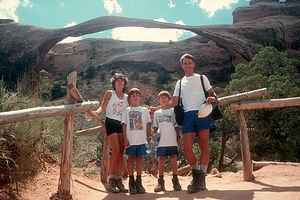 Gaidus Family in 1999The last time we were here, it was so hot that hiking during the afternoon just wasn't viable. All we could do was spray ourselves with the RV outside shower and wait for the sun to go down. This time, the temperature was reasonable enough (low 90s) to do some hiking during the mid part of the day, allowing us to do two long hikes rather than just one. Needless to say, the kids were thrilled. We decided to hike to the Double O Arch in the afternoon, a hike we had never done before, and repeat an old favorite for sunset--the hike to Delicate Arch.
Gaidus Family in 1999The last time we were here, it was so hot that hiking during the afternoon just wasn't viable. All we could do was spray ourselves with the RV outside shower and wait for the sun to go down. This time, the temperature was reasonable enough (low 90s) to do some hiking during the mid part of the day, allowing us to do two long hikes rather than just one. Needless to say, the kids were thrilled. We decided to hike to the Double O Arch in the afternoon, a hike we had never done before, and repeat an old favorite for sunset--the hike to Delicate Arch.
The hike to Double O was pretty long and strenuous--about 5 miles roundtrip. Approximately a mile or so into the hike, there is a turnoff for Landscape Arch, one of the most beautiful arches in the park. This is the arch in the park that really deserves the name Delicate Arch. It is 306 feet long, but so thin that it looks like it could break at any minute. In fact, in 1991 it almost did when a giant 73-foot slab came tumbling off of it. It is now only 11 feet wide at is narrowest point. Since that incident, walking under the arch is prohibited and it must be admired from behind a wood-rail fence. When we first visited this arch in 1999, we took a family photo posed in front of this fence. Since that was our first cross country trip as a family and this one might be our last, we thought it would be a nice idea to repeat the original photo 6 years later. After arguing for awhile about what sequence we should stand in, we called a friend back home and had him look it up on our website. We then lined up appropriately and smiled. I don't think we've changed a bit--well, maybe the kids have a little.
 Gaidus Family in 2005The remainder of the hike got a little bit rougher and even somewhat confusing to follow at times, but we eventually scrambled up through an opening, which was the lower O of the Double O Arch. Once through the arch, we crossed over slick rock to a rocky ledge with the best view of this beautiful pair of arches, in which one big arch stands atop a rock wall with another arch cut out of it--definitely one of the most impressive arches in the park.
Gaidus Family in 2005The remainder of the hike got a little bit rougher and even somewhat confusing to follow at times, but we eventually scrambled up through an opening, which was the lower O of the Double O Arch. Once through the arch, we crossed over slick rock to a rocky ledge with the best view of this beautiful pair of arches, in which one big arch stands atop a rock wall with another arch cut out of it--definitely one of the most impressive arches in the park.
Every year we say we're going to take a family vacation picture to use on our Christmas cards, but we never do. Thinking that maybe this would be the year, Herb began setting up his tripod and lining us up on the ledge. About halfway through this process, a young--and very good looking I might add--man approached us and offered to take our picture for us. Not wanting some stranger to mess up our Christmas shot, Herb politely told him that he had it under control. "I am a photographer," the stranger said. That got my attention. After some further conversation, he modestly informed us that he was a photographer for Outside Magazine, which as any outdoor enthusiast knows, is a very prestigious magazine. Despite the fact that Herb has every issue of Outside since it first came out over 20 years ago, he still wanted to compose and take his own family shot. He did and I think we might actually use it this year.
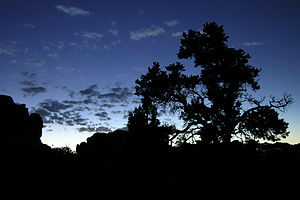 Andrew's night shot experimentThat evening, we hiked to Delicate Arch to watch the sunset--so did most of the visitors to the park. When we had done this hike 2 years ago, it was late afternoon and we practically had the whole Arch to ourselves. Now, there were crowds gathered as if waiting for a fireworks display to begin. Although I definitely prefer hogging it to myself, Delicate Arch is awesome under any circumstances.
Andrew's night shot experimentThat evening, we hiked to Delicate Arch to watch the sunset--so did most of the visitors to the park. When we had done this hike 2 years ago, it was late afternoon and we practically had the whole Arch to ourselves. Now, there were crowds gathered as if waiting for a fireworks display to begin. Although I definitely prefer hogging it to myself, Delicate Arch is awesome under any circumstances.
Herb had been playing around a bit with creating Quick-Time panorama movies and thought that this would be the ideal spot for one. So he placed his camera on the tripod, leveled it, and proceeded to take a series of overlapping pictures in a complete circle around him. These pictures can then be manipulated by software to create a Quick-Time movie. It's a great effect that is the closest thing to actually being there that I have ever seen. I've already started bugging him to put it up on the website for all to see.
That night, back at campground, we took out our beach chairs and just hung out watching the stars. The evening had cooled down nicely, as it does in the desert, so it was very comfortable to be outside. We saw more stars that night than we have ever seen in our lives. The Milky Way was so clear that it seemed like you could reach out and touch it. Andrew used Herb's tripod and took some black and white pictures with long exposures. Later when he developed them, we were quite surprised to see how clearly the stars appeared.
As always, Moab and Arches had been a great stop, and one that I am sure we will return to time and time again. For now though, it was time to start heading east towards home.
Description
Arches National Park contains the greatest concentration of natural arches in the world--more than 2,000, and more are being discovered every day. The park is more than just arches, however. There are also numerous brilliantly-colored balanced rocks, spires, fins, and domes made of the same soft red sandstone.
 The required Delicate Arch photographThe park's 77,000 acres are part of southern Utah's canyonlands, which have been carved and shaped through millions of years of erosion. About 300 million years ago, a 3,000 foot thick layer of salt was left behind in this region when the inland seas evaporated. Over millions of years, debris covered the salt bed and compressed into rock. The salt layer shifted, thrusting the rock layers upward into domes. Further pressures from within the earth produced vertical cracks in the domes. Millions of years of surface erosion gradually stripped away the younger layer of these domes, exposing the salmon-colored Entrada Sandstone and yellow Navajo Sandstone below. The cycle of freezing and melting of water within the cracks in the rocks caused bits of them to break away forming free-standing fins. Wind and water continued to do their job on these fins, breaking off chunks of rock and forming the arches we see today.
The required Delicate Arch photographThe park's 77,000 acres are part of southern Utah's canyonlands, which have been carved and shaped through millions of years of erosion. About 300 million years ago, a 3,000 foot thick layer of salt was left behind in this region when the inland seas evaporated. Over millions of years, debris covered the salt bed and compressed into rock. The salt layer shifted, thrusting the rock layers upward into domes. Further pressures from within the earth produced vertical cracks in the domes. Millions of years of surface erosion gradually stripped away the younger layer of these domes, exposing the salmon-colored Entrada Sandstone and yellow Navajo Sandstone below. The cycle of freezing and melting of water within the cracks in the rocks caused bits of them to break away forming free-standing fins. Wind and water continued to do their job on these fins, breaking off chunks of rock and forming the arches we see today.
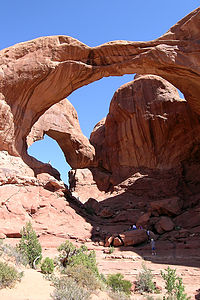 Double ArchUnlike Canyonlands, Arches is much more visitor-friendly in that its treasures are easily accessible. A 41-mile round-trip paved road in the park leads to the major sights, including Balanced Rock, the Windows Section, the Fiery Furnace, and Devil's Garden. From these stops, relatively short trails lead to most of the park's main attractions.
Double ArchUnlike Canyonlands, Arches is much more visitor-friendly in that its treasures are easily accessible. A 41-mile round-trip paved road in the park leads to the major sights, including Balanced Rock, the Windows Section, the Fiery Furnace, and Devil's Garden. From these stops, relatively short trails lead to most of the park's main attractions.
From the Windows Parking lot you can take the 1 ¼ mile Windows Loop past North and South Windows and Turret Arch. Another choice from there is the ½ mile hike to the spectacular Double Arch.
Delicate Arch is probably the best-known feature in the park--it's even on Utah license plates. The hike to Delicate Arch, which is probably the most scenic hike in the park, is a 3-mile round trip, fairly strenuous one across slickrock and along a narrow cliff. However, the dramatic and spectacular view of 45-foot-high, 33-foot-wide Delicate Arch perched on the very edge of a slickrock bowl at the end make every bit of it worthwhile. Because of the heat, this hike should be done either early morning or late afternoon. That's also when the lighting is best for photography.
In the summer, rangers lead a 1 1/2 hour guided walk into the Fiery Furnace, which is named for its sandstone fins that turn flaming red when the lighting is low. Reservations and a fee are required and must be made at the visitor center.
At the end of the scenic drive at Devil's Garden, there is a 52-site campsite which works on a first-come, first-serve basis. It usually fills up quickly, so get there early in the day. The campground is surrounded by spectacular red sandstone rock formations and is the starting point for several hikes into the Devil's Garden.
Moab - Town
Sunday, July 24, 2005 - 6:00am by Lolo148 miles and 3 hours from our last stop - 2 night stay
Travelogue
We were back in Moab, one of my favorite towns of the West. There's just something special about this place, especially if you love the outdoors. The scenery is incredible, the recreational opportunities are endless, and the town itself is full of life, not to mention some great shops and restaurants. Moab has a personality of its own. We had been to Moab twice before, once on our maiden voyage in 1999 and again just two years ago. It's the kind of place that you can come back to time and time again and always find something new to do.
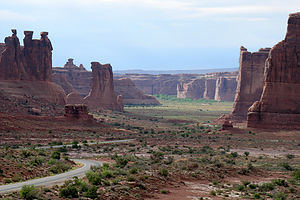 Arches National Park post stormThe first thing on our agenda in Moab was celebrating Tommy's 14th birthday. He had actually turned 14 the day before in Capitol Reef, but refused to count the hike we did in a thunderstorm as an appropriate birthday bash. So, we promised him a night out on the town in Moab, which was something he really was looking forward to. More than anyone else in the family, Tommy loves to shop and eat out. Ironically, he rarely buys anything, but he just loves to browse. Andrew, on the other hand, could care less about shopping, but manages to load up with purchases whenever we do.
Arches National Park post stormThe first thing on our agenda in Moab was celebrating Tommy's 14th birthday. He had actually turned 14 the day before in Capitol Reef, but refused to count the hike we did in a thunderstorm as an appropriate birthday bash. So, we promised him a night out on the town in Moab, which was something he really was looking forward to. More than anyone else in the family, Tommy loves to shop and eat out. Ironically, he rarely buys anything, but he just loves to browse. Andrew, on the other hand, could care less about shopping, but manages to load up with purchases whenever we do.
After getting a campsite at the Canyonlands Campground, the only one right in the heart of the town, we set off down Main Street to do some browsing. Our first goal was Ruby's, the funky store where we had bought the Jimi-Hendrix bathing suit and the windup dancing penises two years ago (see Moab 2003 for a picture of this very unique item). To our dismay, the shop was gone. How disappointing!
Undaunted, we continued up Main Street and found The T-shirt Shop. The place had more t-shirts than I had ever seen in my life, including hundreds of choices for customizing your own. Andrew, who is kind of a retro child of the 60s, bought a great tie-dye t-shirt, with a guitar-like pattern on a black background. To this day, he gets compliments on it whenever he wears it. I tried to encourage Tommy to get something--after all, it was his birthday--but he just couldn't find anything he wanted to buy.
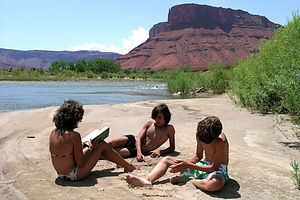 Lolo reading Harry Potter to the youngThere were quite a few photo galleries in town to browse through. Our favorite was the Tom Till Gallery, which had some of the most incredible images of the Moab area that I have ever seen. His photos would make anyone feel insecure as a photographer. He does have the advantage, though, of living in Moab and being able to wait for the perfect lighting and weather conditions in which to capture the dramatic shots that he does. However, I could live here for a life time and never come close to capturing the images he does. It did give us some ideas though of what to strive for.
Lolo reading Harry Potter to the youngThere were quite a few photo galleries in town to browse through. Our favorite was the Tom Till Gallery, which had some of the most incredible images of the Moab area that I have ever seen. His photos would make anyone feel insecure as a photographer. He does have the advantage, though, of living in Moab and being able to wait for the perfect lighting and weather conditions in which to capture the dramatic shots that he does. However, I could live here for a life time and never come close to capturing the images he does. It did give us some ideas though of what to strive for.
Tom wanted to have dinner at the Fat City Smokehouse where he had celebrated his 12th birthday - that's right, this was Tom's second birthday celebration in Moab. Unfortunately, Fat City had gone the way of Ruby's and was no longer in business. We were getting a little paranoid. It seemed like everything we touched last time we were here was gone.
As an alternative, we chose the Moab Brewery, which turned out to be quite nice--good food, great beers, upbeat atmosphere, and friendly service. They brew their beers right on site and most of them are quite good. Herb and I shared a sampler, which consisted of 12 little Dixie cup size glasses, each containing a different beer, with names like Lizard Lite Ale, Dead Horse Amber Ale, Park City Steamer, and other appropriate Utah-like names. We had a really fun waitress to whom we happened to mention that it was Tommy's birthday. When Tom got up to go to the men's room, the waitress informed everyone on the patio that it was Tom's birthday and that they should all join in on a rousing chorus of "Happy Birthday" when he returned. Poor Tom. He really is quite shy. He turned several shades of red when he returned and was greeted by a patio-full of strangers breaking out in song in his honor. I personally think it was pretty cool.
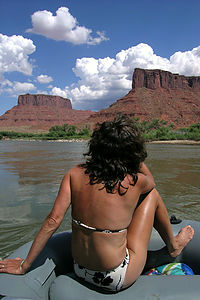 Lolo of the Colorado RiverSince we have a tendency to stick with a good thing once we find it, our plan for the following day was to raft down the Colorado River along the same stretch that we had 2 years ago. We even called the same shuttle service (Coyote Shuttle) to drive us up the river. Fortunately, he had eluded our bad luck touch and was still in business. In fact, it was the very same guy that picked us up last time. As he drove us up the very scenic Utah 128, which ran along the river, he entertained us with tales of foolhardy tourists that had come to unfortunate ends in the harsh lands around Moab. Many of these stories involved mountain bikers that made a wrong turn, got lost, and consequently died of dehydration. He told us that it happens at least a dozen times each year. Some of the trails he mentioned were ones that I had considered doing. It made me feel much better about our decision to raft today rather than mountain bike.
Lolo of the Colorado RiverSince we have a tendency to stick with a good thing once we find it, our plan for the following day was to raft down the Colorado River along the same stretch that we had 2 years ago. We even called the same shuttle service (Coyote Shuttle) to drive us up the river. Fortunately, he had eluded our bad luck touch and was still in business. In fact, it was the very same guy that picked us up last time. As he drove us up the very scenic Utah 128, which ran along the river, he entertained us with tales of foolhardy tourists that had come to unfortunate ends in the harsh lands around Moab. Many of these stories involved mountain bikers that made a wrong turn, got lost, and consequently died of dehydration. He told us that it happens at least a dozen times each year. Some of the trails he mentioned were ones that I had considered doing. It made me feel much better about our decision to raft today rather than mountain bike.
He dropped us and our raft off at Hittle Bottom and we began our 12-mile journey down the river. The water levels were considerably lower than they had been 2 years ago, with much more exposed rock. However, the scenery was just as incredible as always - it was like watching Monument Valley float by. I must admit though that it wasn't quite as good as our trip 2 years ago. It's always more exciting seeing things for the first time. Also, we were a lot less carefree and adventurous this time. Two years ago, the kids and I had spent most of our time out of the raft floating through the rapids with our preservers. That was until we had a scare--Tommy had gotten caught in an eddy that kept pulling him underwater. Thankfully, he got out okay, but we definitely learned a lesson about the possible dangers of the river. So, this time we were much more cautious, probably even too much so, and stayed in the raft for all but the calmest portions.
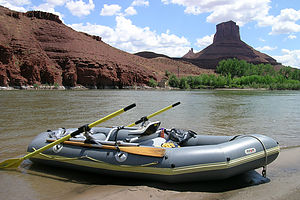 Trusty 21 year old Avon Redshank raft with Northwest River Supplies rowing frameSince we were in no particular hurry, we often just let the raft float along at its own pace. As the afternoon progressed, however, thunderclouds started building, as they so often do on a summer afternoon in Utah, and the wind began to pick up. Not wanting to get caught in a storm, Herb began to row more vigorously. By the time we got to our takeout point at Take Out Beach, the storm was very close. We quickly began the process of deflating and putting away the raft, hoping to finish before the storm hit. Just another 15 minutes and we would have been okay. Instead we had to deal with a wind and sandstorm similar to the one we had experienced at Lake Powell a few days ago. Sand pelted us so hard that it hurt and we could barely keep the raft and its paraphernalia from blowing away. Everything was covered with a layer of sand, including us. It was very scary.
Trusty 21 year old Avon Redshank raft with Northwest River Supplies rowing frameSince we were in no particular hurry, we often just let the raft float along at its own pace. As the afternoon progressed, however, thunderclouds started building, as they so often do on a summer afternoon in Utah, and the wind began to pick up. Not wanting to get caught in a storm, Herb began to row more vigorously. By the time we got to our takeout point at Take Out Beach, the storm was very close. We quickly began the process of deflating and putting away the raft, hoping to finish before the storm hit. Just another 15 minutes and we would have been okay. Instead we had to deal with a wind and sandstorm similar to the one we had experienced at Lake Powell a few days ago. Sand pelted us so hard that it hurt and we could barely keep the raft and its paraphernalia from blowing away. Everything was covered with a layer of sand, including us. It was very scary.
Safely back in the RV, we tried to regroup and decide what to do next. Since we had no plans for the night yet and the sky was looking quite dramatic, we decided to quickly drive into Arches National Park and try to emulate some Tom Till photographs. On the way in, we checked for campsite availability in the Devils Garden Campground, but were told that it had filled up early that morning. We would later find out that we were lucky we didn't get in that night (see next day's writings).
We hurried along the scenic drive through the park racing to an overlook before the sky cleared. We were just about 15 minutes too late for the really dramatic stuff, but we did manage to get off a few good shots. Meanwhile, I called the Canyonlands Campground and was able to get our site back for another night.
Back in Moab, we saw that the storm had had a pretty dramatic effect on the town as well. The usually dry creek bed that is the Mill Creek in Spring, was now a raging river of red silt flowing under the bridges through town. The streets were crowded with people and a party atmosphere filled the air - I just love this place!
Description
Moab is the largest town in southeastern Utah with a population of 5,500. It lies in a green valley near the Colorado River and is surrounded by high sandstone cliffs. Its location makes it an excellent base for exploring Arches and Canyonlands National Parks. In the past 20 years of so, it has become a mecca for outdoor enthusiasts or “yummies” (young urban macho men into extreme sports), who flock here to mountain bike, river run, rock climb, four-wheel drive, hike, etc. It is the most youthful and vibrant community in Utah, and the Main Street through town reflects that with its numerous restaurants, bars, and shops.
Capitol Reef National Park
Friday, July 22, 2005 - 4:30am by Lolo80 miles and 2 hours from our last stop - 2 night stay
Travelogue
We had been to Capitol Reef before, but hadn't really done it justice. During that first visit, the scenic road was closed because of flashfloods, so all we did was drive through the park on Route 24, stopping at some of the sights along the way. Nice, but nothing that really stood out for me. This time, however, was really different, and I have come to truly love the beauty of Capitol Reef.
 Tommy getting waterfall big airIt started off on a high note with what would become one of our trip highlights. As we were driving west along Route 24 towards the Visitor Center, Herb noticed a bunch of cars parked on the side of the road. He glanced over and just barely caught sight of a beautiful waterfall cascading over the red rocks to our right. We could very easily have missed it. In fact, the last time we were here, we did. Perhaps it was because we were driving in the opposite direction and would have had to look back to see it. There was absolutely nothing written up about it in any of the guidebooks or the park brochure.
Tommy getting waterfall big airIt started off on a high note with what would become one of our trip highlights. As we were driving west along Route 24 towards the Visitor Center, Herb noticed a bunch of cars parked on the side of the road. He glanced over and just barely caught sight of a beautiful waterfall cascading over the red rocks to our right. We could very easily have missed it. In fact, the last time we were here, we did. Perhaps it was because we were driving in the opposite direction and would have had to look back to see it. There was absolutely nothing written up about it in any of the guidebooks or the park brochure.
We parked the RV and climbed down a path through some bushes to the base of the falls where we found a group of people having a great time swimming in the pool under the falls. We quickly joined them. It was delightful. The falls were about 20 feet high and quite powerful. We really had to fight to get underneath them as the force of the pounding water pushed us away. It was exhilarating. The boys followed some other brave souls up the slippery rocks alongside the falls and then jumped into the middle of them. Thanks to digital photography, we got some great mid-air shots of them flying through the spray.
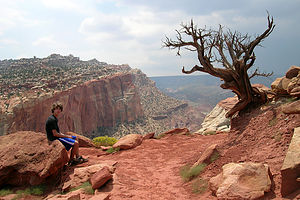 Tommy on approach to Cassidy ArchAfter about an hour, we reluctantly left the falls and headed towards the main part of the park. Capitol Reef didn't owe us anything from this point. It had already far exceeded our expectations, and we hadn't even gotten to the main part of the park yet.
Tommy on approach to Cassidy ArchAfter about an hour, we reluctantly left the falls and headed towards the main part of the park. Capitol Reef didn't owe us anything from this point. It had already far exceeded our expectations, and we hadn't even gotten to the main part of the park yet.
When we arrived at the Fruita Campground, just a short distance past the Visitor Center, we knew right away that we had to spend some time here - at least a night or two. I do love the stark beauty of the desert, but the greenness of this campground and the flowing water of the Fremont River were a very welcome respite. It was great! There were actually trees, and there were acres of fruit orchards right next to the campground where you could wander and pick fruit.
For some reason, the kids just couldn't wait to do some fruit picking. I've never seen them display such a strong interest in fruit before, but I guess it was the novelty of using the long fruit picking sticks that intrigued them. They were hoping for peaches or apples, but they had to make do with apricots because that was the fruit currently in season. I don't think they even knew what an apricot looked like, much less tasted like, but they were still pretty enthused. They know how to make a good time out of practically anything we do, which is quite refreshing, especially considering they're teenagers. The trees had been picked pretty bare already, but we had fun anyway and did manage to collect a few good ones.
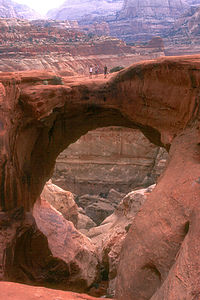 Lolo and the boys on Cassidy ArchOur campsite was great--plenty of room between neighbors and great views of the red rock cliffs across from us. We set out our beach chairs and just relaxed for awhile, but not for too long. There were too many things to do.
Lolo and the boys on Cassidy ArchOur campsite was great--plenty of room between neighbors and great views of the red rock cliffs across from us. We set out our beach chairs and just relaxed for awhile, but not for too long. There were too many things to do.
That evening we hiked the Fremont River Trail, which was recommended by the park ranger as the best hike to take at sunset. She was right. The trail started right from the campground and meandered through the orchards along the river--it didn't feel like we were in Utah at all. After about ½ mile, the trail climbed quite steeply for another ¾ mile or so up to a lovely overlook above the river and valley. We would have spent a lot more time up there enjoying and photographing the view if it hadn't been for the thunderclouds that were swiftly moving towards us. With the wide open skies out west, you can really see a thunderstorm coming. We scurried back down to the campground in time to avoid the storm.
The next morning was Tommy's 14th birthday--his fifth to be celebrated on the road. He had spent his 9th birthday having lunch at the beautiful Prince of Wales Hotel in Waterton-Glacier National Park, his 10th mountain biking down Whistler-Blackcomb Mountain in British Columbia, his 12th rafting down the Colorado River near Moab, and his 13th on beautiful Newfoundland. Needless to say, he had expectations. I think he would have liked to spend his birthday at an amusement or water park, but that was not really an option in this part, or probably any part, of Utah. So we broke him the good news. For his special day, we had a sort of biathlon planned--a 3 ½ mile bike ride to the end of the Grand Wash Road, followed by a 3 ½ mile strenuous hike to the top of Cassidy Arch (where Butch Cassidy supposedly hid out), and then, of course, the 3 ½ mile ride back to the campground. He tried to control his enthusiasm.
The bike ride portion consisted of about 2 miles on the hilly but paved scenic drive, and then another mile or so on the unpaved Grand Wash Road. The boys liked the unpaved part where they invented a new riding style--stomachs on the bike seat and legs straight out behind them like superman. The only body part in the right place was their hands on the handlebars.
 Lolo and the boys picking apricotsAt the end of the Grand Wash Road, we locked our bikes up and started the hiking portion of the day. The hike began at the floor of the Grand Wash--a place you probably didn't want to be at after a big rain--and climbed steeply to the top of high cliffs overlooking the park. It was pretty strenuous. About half way up, we began to hear thunder rumbling in the distance. Tommy, always the most sensible of all of us, wanted to turn back. The rest of us really wanted to get to the Arch--three against one. We practically ran the rest of the way up the steep trail, hoping to beat out the storm. By the time we got to the top, the storm was really close. The kids and I quickly ran out on top of the arch so Herb could photograph us, but it was getting pretty scary. The rain was starting and the time between the lightning and the thunder was getting closer and closer. Poor Herb never even got a chance to go out on the Arch, which, by the way, looked a lot scarier from the photos than it was. It really is pretty wide--even by my wimpy standards. A heated debate began as to what we should do. Some of us wanted to find shelter under a rock overhang and wait out the storm. Herb suggested we get out of there as soon as possible. There was no telling how long the storm would last, and the slick rock that we had climbed to get here was only going to get slipperier with more rain. Tom was mad we were in this position at all and mentioned something about bad parenting. We decided to go with Herb's plan and started to run, probably breaking the record for the quickest descent of this trail. We ran the whole way. Back at the bottom, we jumped on our bikes and pedaled as fast as we could through the muck on the Grand Wash Road. The mud was shooting up from our tires and painting a stripe on our backs. By the time we got back to the campground, the storm had subsided and the sun was beginning to peek out. We, however, were a mess. Tommy wouldn't even speak to any of us for the next couple of hours.
Lolo and the boys picking apricotsAt the end of the Grand Wash Road, we locked our bikes up and started the hiking portion of the day. The hike began at the floor of the Grand Wash--a place you probably didn't want to be at after a big rain--and climbed steeply to the top of high cliffs overlooking the park. It was pretty strenuous. About half way up, we began to hear thunder rumbling in the distance. Tommy, always the most sensible of all of us, wanted to turn back. The rest of us really wanted to get to the Arch--three against one. We practically ran the rest of the way up the steep trail, hoping to beat out the storm. By the time we got to the top, the storm was really close. The kids and I quickly ran out on top of the arch so Herb could photograph us, but it was getting pretty scary. The rain was starting and the time between the lightning and the thunder was getting closer and closer. Poor Herb never even got a chance to go out on the Arch, which, by the way, looked a lot scarier from the photos than it was. It really is pretty wide--even by my wimpy standards. A heated debate began as to what we should do. Some of us wanted to find shelter under a rock overhang and wait out the storm. Herb suggested we get out of there as soon as possible. There was no telling how long the storm would last, and the slick rock that we had climbed to get here was only going to get slipperier with more rain. Tom was mad we were in this position at all and mentioned something about bad parenting. We decided to go with Herb's plan and started to run, probably breaking the record for the quickest descent of this trail. We ran the whole way. Back at the bottom, we jumped on our bikes and pedaled as fast as we could through the muck on the Grand Wash Road. The mud was shooting up from our tires and painting a stripe on our backs. By the time we got back to the campground, the storm had subsided and the sun was beginning to peek out. We, however, were a mess. Tommy wouldn't even speak to any of us for the next couple of hours.
 Andrew getting waterfall big airNow that the sun was back out, we decided to return to the waterfall, hoping to have the same great experience as the day before, and possibly get Tommy to speak to us again. What a difference a day makes. The falls looked completely different. When it rains around here, that beautiful red sand and rock that I love so much gets washed right along with the runoff. Our crystal clear waterfall from the day before was now a cloudy red. They all made fun of me when I said that the falls looked liked a salmon fillet, but it did. It wasn't nearly as inviting to swim in as the day before. I wonder how long it takes it to return to clear. Tommy eventually forgot he was mad at us and started speaking to us again. It was good to have him back.
Andrew getting waterfall big airNow that the sun was back out, we decided to return to the waterfall, hoping to have the same great experience as the day before, and possibly get Tommy to speak to us again. What a difference a day makes. The falls looked completely different. When it rains around here, that beautiful red sand and rock that I love so much gets washed right along with the runoff. Our crystal clear waterfall from the day before was now a cloudy red. They all made fun of me when I said that the falls looked liked a salmon fillet, but it did. It wasn't nearly as inviting to swim in as the day before. I wonder how long it takes it to return to clear. Tommy eventually forgot he was mad at us and started speaking to us again. It was good to have him back.
When we got back to the campground, Herb had us switch sites to the other side of the campground where we had an even better view of the cliffs. Herb doesn't ask for much on these trips and usually lets me run the show, but the one thing that he is obsessed with is being able to sit back in his chair in the evening after a hard day of having fun, cocktail in hand and great scenery all around him. Well, he got it. Last night's view wasn't too shabby, but this one was spectacular.
Also, we were now next to the Gifford house, an early 1900s Mormon farmhouse, which was quite picturesque. The Fruita area was first settled by Mormon pioneers in the 1880s, who were attracted to this area because of its fertility and potential for orchards. Speaking of fertility, records show that these first settlers were Mormon polygamists seeking refuge from the Federal government's enforcement of anti-polygamy laws.
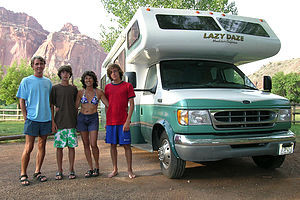 Family with the Lazy Daze at the Fruita CampgroundI usually like to know about the history of places we visit, but I realized that I didn't know much at all about the Mormon faith and the role that polygamy plays in their religion. Since our trip, I have read Jon Krakauer's book , which gives an interesting and frightening account of the history of Mormon Fundamentalism. The main Mormon Church stopped practicing polygamy a long time ago, but a group of extremists, or Fundamentalists, have broken away from the main church and are still practicing it today in various parts of Utah and northern Arizona. It was kind of creepy to think that these things were going on in modern-day America and not very far from where we traveled.
Family with the Lazy Daze at the Fruita CampgroundI usually like to know about the history of places we visit, but I realized that I didn't know much at all about the Mormon faith and the role that polygamy plays in their religion. Since our trip, I have read Jon Krakauer's book , which gives an interesting and frightening account of the history of Mormon Fundamentalism. The main Mormon Church stopped practicing polygamy a long time ago, but a group of extremists, or Fundamentalists, have broken away from the main church and are still practicing it today in various parts of Utah and northern Arizona. It was kind of creepy to think that these things were going on in modern-day America and not very far from where we traveled.
The next morning before we left, we spent some time photographing the Gifford homestead. Andrew was still working on shooting those 5 rolls of black and white film for his summer photography assignment. I think he got some good shots. One of them was of a pair of red long johns hanging on the laundry line outside the farmhouse. He was hoping to print it in black and white and then hand-color the long johns red. I think that will be a pretty interesting effect.
Well, it was time to leave Capitol Reef and head to another one of our favorite places- Moab, Utah. I'm really glad we got to see more of Capitol Reef this time though. It's a very special and unique place, and one that I will definitely want to come back to.
Description
Capitol Reef National Park in south central Utah is much less well known and therefore much less crowded than most of Utah's other national parks, such as Zion and Bryce. However, this undiscovered treasure offers some of the most spectacular scenery in Utah.
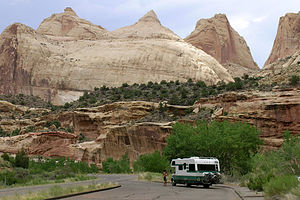 Lazy Daze on entrance to Capitol ReefThe park's central geological feature--the Waterpocket Fold- was formed more than 70 million years ago when forces within the earth began to uplift, squeeze, and fold dozens of rock formations into a giant 100-mile long wrinkle in the Earth's crust. It was named Waterpocket because of the many pools of water that get trapped in the tilted strata. Brilliantly colored rock spires, domes, canyons, and arches were carved out of the fold by millions of years of erosion.
Lazy Daze on entrance to Capitol ReefThe park's central geological feature--the Waterpocket Fold- was formed more than 70 million years ago when forces within the earth began to uplift, squeeze, and fold dozens of rock formations into a giant 100-mile long wrinkle in the Earth's crust. It was named Waterpocket because of the many pools of water that get trapped in the tilted strata. Brilliantly colored rock spires, domes, canyons, and arches were carved out of the fold by millions of years of erosion.
Capitol Reef was named by explorers who found the cliffs of the Waterpocket Fold to be a barrier to their travel west. Many of these explorers had been seafaring men, so the rock barriers reminded them of an ocean "reef" blocking ocean travel. The rounded sandstone domes in the park reminded them of the domes on "capitol" buildings; hence the name Capitol Reef.
In stark contrast to the brilliant cliffs and barren desert of the park is the lush oasis of cottonwood, willow, and ash trees along the banks of the Fremont River. In the 1880's, Mormon pioneers established the community of Fruita here and planted orchards along the river's rich banks. These orchards, as well as a schoolhouse, blacksmith shop, and the Behunin Cabin, have been preserved here by the National Park Service. There is a campground and picnic area here as well.
 Gifford Farmhouse BarnOther evidence of much earlier human habitation can be found in the thousand-year-old petroglyphs left behind by the ancient Fremont and Anasazi people.
Gifford Farmhouse BarnOther evidence of much earlier human habitation can be found in the thousand-year-old petroglyphs left behind by the ancient Fremont and Anasazi people.
From Route 24, which crosses Capitol Reef National Park from east to west, you can see some of the park's best features, such as Capitol Dome, Chimney Rock, the Fruita Schoolhouse, and the roadside petroglyphs.
If you have more time, drive the paved 25-mile roundtrip scenic drive, which has excellent views of the dramatic canyons and rock formations of Capitol Reef. At the end of the scenic drive is the gravel Capitol Gorge Road, a 5-mile loop with what many think is the best scenery in the park.
Lake Powell - Halls Crossing
Wednesday, July 20, 2005 - 4:00am by Lolo57 miles and 1.25 hours from our last stop - 2 night stay
Travelogue
Our drive from Natural Bridges to Halls Crossing took us along Route 276, one of the few smaller highways in Utah not marked with those little dots on the map that signify a scenic road. Well, they must have just run out of dots because this road was incredible, and we were literally the only ones on it. At one point, Herb wanted to take a picture of the canyons we were driving through, so he just stopped the RV in the middle of the road, got out, and took a picture.
 Lolo hiking up Lost Eden CanyonThe approach road was a sure giveaway that the Halls Crossing section of Lake Powell was going to be a lot different from the hustle and bustle of Page. We had our choice of two campgrounds right across from each other. The one on the left side of the road sat on a bluff with views of the lake below. It had no water or hookups. The one on the right side of the road had hookups but no view of the lake. We chose to forsake the comforts of air conditioning and go for the view. Besides, this was the desert and it cooled down at night--didn't it?
Lolo hiking up Lost Eden CanyonThe approach road was a sure giveaway that the Halls Crossing section of Lake Powell was going to be a lot different from the hustle and bustle of Page. We had our choice of two campgrounds right across from each other. The one on the left side of the road sat on a bluff with views of the lake below. It had no water or hookups. The one on the right side of the road had hookups but no view of the lake. We chose to forsake the comforts of air conditioning and go for the view. Besides, this was the desert and it cooled down at night--didn't it?
We couldn't wait to get out on the lake. The temperature was over 100 and the water looked extremely inviting. We drove down to the boat launch, quickly inflated our 12-foot Avon raft, and filled it with everything we would need for a day of fun out on the lake. While our 6 hp motor was not exactly going to zip us around the lake, it would enable us to do some slow-speed, close-up exploration of the many coves and canyons in Halls Creek Bay.
 Family with trusty 21 year old Avon Redshank raftThe lake levels were really low. Way up on the wall of the canyon you could see the change in coloration line from where the water line normally was. It must have been about 70 feet down from its high point. The marinas at this end of the lake are really having a hard time. Halls Crossing Marina is no longer renting boats and Hite Marina, a bit further up the lake, is totally closed as there is no longer any water there. Their houseboats have been brought down to Halls Crossing and are sitting up on the land like beached whales. It made me kind of sad to look at them.
Family with trusty 21 year old Avon Redshank raftThe lake levels were really low. Way up on the wall of the canyon you could see the change in coloration line from where the water line normally was. It must have been about 70 feet down from its high point. The marinas at this end of the lake are really having a hard time. Halls Crossing Marina is no longer renting boats and Hite Marina, a bit further up the lake, is totally closed as there is no longer any water there. Their houseboats have been brought down to Halls Crossing and are sitting up on the land like beached whales. It made me kind of sad to look at them.
We had not been out on the lake more than 30 minutes before we noticed an official looking boat headed our way. Although we knew we weren't doing anything wrong--our boat registration was properly displayed, there were 4 life preservers in the boat, and there was no possible way we were speeding--we still broke out in a sweat.
As the rangers pulled up along our boat, one of them asked, "Where did you come from in that vessel?"
"New Jersey," I stupidly replied.
"No, I mean where did you come from right now?"
"Oh," Herb said pointing toward the boat launch, which was still in sight after 30 minutes of our not so swift travel.
"I've never seen a boat quite like that one out on this lake."
 Lolo demonstrating use of the floatWe weren't sure whether we should be embarrassed or proud. Also, I wasn't quite sure just where this conversation was going. Then things lightened up. Actually I think they were always light, but we just had the typical reaction to being pulled over by a cop. I think they were just bored and we were a bit of a curiosity. They gave us some good advice on nearby destinations that a boat of our speed could reach on a day trip. We said goodbye and sped away (kind of).
Lolo demonstrating use of the floatWe weren't sure whether we should be embarrassed or proud. Also, I wasn't quite sure just where this conversation was going. Then things lightened up. Actually I think they were always light, but we just had the typical reaction to being pulled over by a cop. I think they were just bored and we were a bit of a curiosity. They gave us some good advice on nearby destinations that a boat of our speed could reach on a day trip. We said goodbye and sped away (kind of).
We spent that day exploring Lost Eden Canyon. We followed one particular canyon that eventually narrowed to the width of our boat. At the end, we tried to climb up the walls that rose about 6 feet above our heads so that we could explore further into the canyon by foot. Andrew made the first attempt by putting one leg on each wall and trying to straddle his way up. After almost doing an unintentional split, he gave up and practically fell back into the boat. Herb had a bit more luck and actually made it to the top, but by that time none of us wanted to follow. He looked a bit like a cat caught up a tree in his attempts to get back down into the boat.
Meanwhile, we heard a banging noise coming from the entrance to the canyon. There was some idiot in a rental boat trying to come in despite the fact that his boat was wider than the entry. He left quite a bit of fiberglass on the rock before he finally gave up.
 Boy's demonstrating the use of the scrotum squeezerThere weren't that many beaches to pull up on in this part of the lake, so we found a good spot in a wider part of the canyon to just hang out for the afternoon and swim from the boat. We couldn't even see the entrance to the canyon, so it felt like we were in an amphitheater with 100-foot walls rising out of the water all around us. The echoes were great--if only I could yodel. Since there was no beach to swim from, our two collapsible floats really came in handy. The kids solved their floatation issue by wearing two life preservers each--one the normal way and the other one through their legs, kind of like a diaper. I hesitate to mention their name for this new invention, but here it goes--the "scrotum squeezer." They are teenagers after all. I thought they looked like buoys bobbing about in the water. I had brought a "pinky" ball along, which managed to entertain us for hours. We had discovered the joys of chucking a "pinky" ball against the canyon walls on our last visit to the lake two years ago. With their new method of flotation, the game got even more entertaining.
Boy's demonstrating the use of the scrotum squeezerThere weren't that many beaches to pull up on in this part of the lake, so we found a good spot in a wider part of the canyon to just hang out for the afternoon and swim from the boat. We couldn't even see the entrance to the canyon, so it felt like we were in an amphitheater with 100-foot walls rising out of the water all around us. The echoes were great--if only I could yodel. Since there was no beach to swim from, our two collapsible floats really came in handy. The kids solved their floatation issue by wearing two life preservers each--one the normal way and the other one through their legs, kind of like a diaper. I hesitate to mention their name for this new invention, but here it goes--the "scrotum squeezer." They are teenagers after all. I thought they looked like buoys bobbing about in the water. I had brought a "pinky" ball along, which managed to entertain us for hours. We had discovered the joys of chucking a "pinky" ball against the canyon walls on our last visit to the lake two years ago. With their new method of flotation, the game got even more entertaining.
After an absolutely wonderful day out on the lake, we cruised our way back over to the boat ramp where we had left our motorhome. Rather than go through the entire process of disassembling and reassembly the raft for the next day, Herb--always the handy one--rigged up a method of attaching it fully inflated to the bike rack in back of the RV. We just had to drive slow and remove it before backing into the cottonwood tree on our campsite. It worked perfectly.
 Lolo inside Lost Eden CanyonThe view from our site was so pretty that it hardly looked real. There was a hot breeze blowing off the lake and the sun was getting low. Herb and I relaxed in our beach chairs enjoying the view while the boys stalked lizards. They used a Tupperware container as a sort of lizard photography studio. They filled it with grass and twigs to create a natural backdrop and then practiced some close-up photography.
Lolo inside Lost Eden CanyonThe view from our site was so pretty that it hardly looked real. There was a hot breeze blowing off the lake and the sun was getting low. Herb and I relaxed in our beach chairs enjoying the view while the boys stalked lizards. They used a Tupperware container as a sort of lizard photography studio. They filled it with grass and twigs to create a natural backdrop and then practiced some close-up photography.
I kept expecting that hot breeze coming off the lake to turn into a cool one as the evening progressed, but it never did. We spent a pretty uncomfortable night sleeping in the RV without air conditioning. The first thing we did the next morning was drive across the street to the other campground and book a site with electric. There wasn't a view, but I didn't care. We would see enough of the lake all day long, and I wanted a good night's sleep that night.
We relaunched our trusty blow-up boat and spent another great day out on the lake. This time we explored Halls Creek Bay, which was much larger and more open than the canyon we had been in the day before. Although we didn't find any beaches, we were able to pull the raft up onto a flat rock and then hike up the slickrock to a great viewpoint. It was another wonderful day out on the lake.
 Halls Crossing Primitive CampgroundThat night back at our campsite, we got to experience a more frightening part of desert life. The kids had just come back from a run and I was happily making dinner in the comfort of my now air-conditioned motorhome when I heard what sounded like rain hitting the roof of the RV. Tommy and I quickly ran out to take in the towels only to find ourselves in the middle of a really bad sand storm. The wind was blowing so hard that the sand was pelting us and we couldn't see more than 6 inches in front of us. Somehow we managed to grab the towels and get back inside. Herb and Andrew, who had no idea of what was going on outside, looked at us in amazement. We were totally covered in sand. It was actually a quite painful and scary experience.
Halls Crossing Primitive CampgroundThat night back at our campsite, we got to experience a more frightening part of desert life. The kids had just come back from a run and I was happily making dinner in the comfort of my now air-conditioned motorhome when I heard what sounded like rain hitting the roof of the RV. Tommy and I quickly ran out to take in the towels only to find ourselves in the middle of a really bad sand storm. The wind was blowing so hard that the sand was pelting us and we couldn't see more than 6 inches in front of us. Somehow we managed to grab the towels and get back inside. Herb and Andrew, who had no idea of what was going on outside, looked at us in amazement. We were totally covered in sand. It was actually a quite painful and scary experience.
The next morning we rose early to catch the ferry to Bull Frog. This ferry, which is run by the state, makes the half-hour journey across Halls Creek every 2 hours, so we wanted to make sure we didn't miss it. Its price was pretty reasonable -- $32 for the RV and passengers are free. Afterwards I heard a rumor that because of the lake levels, the state might stop running this ferry in the future, so make sure you check on its status before depending on it. After departing the ferry, we headed north through some very pretty yet desolate scenery on our way to Capitol Reef.
Lake Powell still keeps its position as our family's all-time favorite place on earth. It will take a lot more than a little sand storm to knock it from that position.
Description
Lake Powell is the centerpiece of the Glen Canyon National Recreation Area's 1.25 million acres of beautiful desert and canyon country. It is considered by many to be one of the most scenic lakes in the country, with its clear turquoise water surrounded by red sandstone rock formations and steep remote side canyons.
 Sunset view from Halls Crossing CampgroundLake Powell is the second largest man-made lake in the country (Lake Meade is the largest), stretching 186 miles from Page, Arizona to Hite, Utah. Its 1,960 miles of shoreline with its hundreds of bays, coves, and canyons provides seemingly limitless opportunities for exploration by boat, truly the best way to access the beauty of this area.
Sunset view from Halls Crossing CampgroundLake Powell is the second largest man-made lake in the country (Lake Meade is the largest), stretching 186 miles from Page, Arizona to Hite, Utah. Its 1,960 miles of shoreline with its hundreds of bays, coves, and canyons provides seemingly limitless opportunities for exploration by boat, truly the best way to access the beauty of this area.
For those that don't have their own boat, there are boat tours to various destinations on the lake, such as Rainbow Bridge, the world's largest natural bridge, and numerous marinas from which to rent boats for fishing, skiing, or houseboating. Houseboating has become an extremely popular activity on the lake.
The main base for people visiting Lake Powell is the Wahweap Resort and Marina in Page, Arizona. Facilities here include a marina, lodging, restaurants and shops, boat tours, and a campground. Also near Page are the Glen Canyon Dam and the Carl Hayden Visitor Center.
Other less accessible points to the lake include Hite, Bullfrog Bay, and Halls Crossing, all of which are in Utah.
- Halls Crossing, which is reached from Blanding, Utah, via state highways, has a ranger station, launch ramp, marina, store, housekeeping units, and two campgrounds.
- Bullfrog Bay is reached from Hanksville, Utah, via paved state highways. Facilities include a visitor center, launch ramp, marina, store, lodging, and two campgrounds. A ferry runs between Halls Crossing and Bullfrog Bay.
- Hite, at the extreme north of the lake, is reached via the Bicentennial Highway. Facilities include a ranger station, launch ramp, marina, lodging, store, and primitive camping. Many people find the area around Hite to be the most scenic in the recreation area.
The creation of the Glen Canyon Dam across the Colorado River, and the subsequent creation of Lake Powell, was one of the most controversial engineering projects in history, contributing to the birth of the modern day environmental movement. When the dam was completed in 1963, it flooded what was considered by many to be one of the most beautiful canyons in the southwest, the Glen Canyon. Today there is a movement to dismantle the dam and return the area to what it once was.
Natural Bridges National Monument
Tuesday, July 19, 2005 - 9:00am by Lolo237 miles and 5 hours from our last stop - 1 night stay
Travelogue
Natural Bridges was one of those very pleasant surprises--strikingly beautiful and completely devoid of crowds. Definitely our kind of place.
 Sipapu Bridge LookoutI was a bit concerned about finding a campsite, since the guidebook indicated that the small 13-site campground in the park could only accommodate RVs under 21 feet. However, there was no problem at all. The campground was practically empty, and the sites weren't all that small. We were able to comfortably tuck our 26½-foot motorhome into one of the sites in this lovely pinyon and juniper forest.
Sipapu Bridge LookoutI was a bit concerned about finding a campsite, since the guidebook indicated that the small 13-site campground in the park could only accommodate RVs under 21 feet. However, there was no problem at all. The campground was practically empty, and the sites weren't all that small. We were able to comfortably tuck our 26½-foot motorhome into one of the sites in this lovely pinyon and juniper forest.
My only regret is that we got here so late in the day. There were three spectacular bridges to explore, but we would only have time to do two of them--greatly disturbing my obsessive need to see them all. After being told to get over it, we chose two: Sipapu because it is the largest and most spectacular and Owachomo because it is the most elegant and frailest (it might not be here the next time we pass through).
 Boys on Sipapu Bridge HikeWe quickly headed out on the scenic Bridge View Drive, a 9-mile loop through the park past the trailheads for each of the bridges. Our first stop was the trailhead for Sipapu Bridge. It was so hot out that before beginning our hike we used the RV outdoor shower to soak ourselves. Feeling refreshed, we began our descent down into the canyon, which included climbing down a wooden ladder--not bad considering early visitors to the park had to use a tree. About halfway down the trail, we came out on a ledge, directly across from and slightly above, Sipapu Bridge. The view down into the canyon and across to the bridge was so incredible that we knew we had to go no further. Hiking the remaining switchbacks down to the base of the bridge was only going to use up more valuable time before sunset, and we were pretty sure that the view from the base couldn't compare with what we had right here on the ledge. We took lots of pictures.
Boys on Sipapu Bridge HikeWe quickly headed out on the scenic Bridge View Drive, a 9-mile loop through the park past the trailheads for each of the bridges. Our first stop was the trailhead for Sipapu Bridge. It was so hot out that before beginning our hike we used the RV outdoor shower to soak ourselves. Feeling refreshed, we began our descent down into the canyon, which included climbing down a wooden ladder--not bad considering early visitors to the park had to use a tree. About halfway down the trail, we came out on a ledge, directly across from and slightly above, Sipapu Bridge. The view down into the canyon and across to the bridge was so incredible that we knew we had to go no further. Hiking the remaining switchbacks down to the base of the bridge was only going to use up more valuable time before sunset, and we were pretty sure that the view from the base couldn't compare with what we had right here on the ledge. We took lots of pictures.
 Tommy on the ladder to Sipapu BridgeThen back up the ladders, into the RV, and on to the next trailhead. It killed me as we zipped past the one for Kachina Bridge, but there just wasn't time. The sun was already getting pretty low. The hike to Owachomo was much shorter and easier, so we were at its base in no time. This was a much different perspective than the view we had of Sipapu--up close and underneath looking up at it. The bridge really is quite frail--erosion has worn it down to a width of only 9 feet. The lighting was going fast, so we quickly took some photos. Tommy spent most of his time stalking a lizard with his camera, and he did manage to get some pretty good close-ups. Thank god for digital--he must have taken over 20 shots.
Tommy on the ladder to Sipapu BridgeThen back up the ladders, into the RV, and on to the next trailhead. It killed me as we zipped past the one for Kachina Bridge, but there just wasn't time. The sun was already getting pretty low. The hike to Owachomo was much shorter and easier, so we were at its base in no time. This was a much different perspective than the view we had of Sipapu--up close and underneath looking up at it. The bridge really is quite frail--erosion has worn it down to a width of only 9 feet. The lighting was going fast, so we quickly took some photos. Tommy spent most of his time stalking a lizard with his camera, and he did manage to get some pretty good close-ups. Thank god for digital--he must have taken over 20 shots.
Once back at the RV, Andrew began complaining about a painful burning sensation in his foot. Having definite hypochondriac tendencies, he became convinced that a scorpion had bit him and that death was imminent. Knowing his son all too well, Herb calmly took off Andrew's sneaker and removed the cactus burrs that were clinging to his sock.
We got back to the campground just as it was getting dark. Parked in the campsite right across from us was another Lazy Daze motorhome, just like ours. It might not sound like a big deal, but they are somewhat rare so the fact that 2 out of the 5 families in this campground had Lazy Dazes was pretty exciting for us. Maybe exciting is too strong a word, but it did get our attention.
Description
 Owachomo BridgeNatural Bridges National Monument in southeastern Utah is part of the Great Basin Desert of the Colorado Plateau. Its elevation ranges from 5,500 feet in the bottom of the canyon to 6,500 feet on top of the pinyon and juniper covered mesa. The most prominent and best-known features of the park are its three large natural bridges--Sipapu, Kachina, and Owachomo. Sipapu and Kachina are the second and third largest natural bridges in the world.
Owachomo BridgeNatural Bridges National Monument in southeastern Utah is part of the Great Basin Desert of the Colorado Plateau. Its elevation ranges from 5,500 feet in the bottom of the canyon to 6,500 feet on top of the pinyon and juniper covered mesa. The most prominent and best-known features of the park are its three large natural bridges--Sipapu, Kachina, and Owachomo. Sipapu and Kachina are the second and third largest natural bridges in the world.
 Tommy on Sipapu Bridge HikeThe bridges were formed millions of years ago by the action of the streams that flowed through the canyon. These streams, which flowed in wide meandering loops, eventually broke through the rock fins separating its loops. The streams then shifted directions and took a short cut through what became a natural bridge. Natural bridges look a lot like arches, but they are different in the way they are formed. Natural bridges are carved out of rock by flowing water, while arches are formed by frost and seeping water erosion.
Tommy on Sipapu Bridge HikeThe bridges were formed millions of years ago by the action of the streams that flowed through the canyon. These streams, which flowed in wide meandering loops, eventually broke through the rock fins separating its loops. The streams then shifted directions and took a short cut through what became a natural bridge. Natural bridges look a lot like arches, but they are different in the way they are formed. Natural bridges are carved out of rock by flowing water, while arches are formed by frost and seeping water erosion.
Each of the three bridges in the park illustrates a different stage of bridge development:
- Owachomo is the oldest bridge and, therefore, the most slender and frail. It is also the most elegant. It spans 180 feet and is 106 feet high, but the forces of erosion have worn its bridge to a thickness of only 9 feet.
- Sipapu Bridge is the largest and most spectacular of the three bridges. It has a span of 268 feet and a height of 220 feet, large enough to fit the dome of the Capitol building. In the life span of a bridge, it is considered middle-aged. It's bridge has had less time to erode and is 53 feet thick.
- Kachina is the youngest of the bridges. It is much thicker (93 feet) and has the smallest opening of the three. Its opening would be even smaller, but in 1992, 4,000 tons of sandstone fell from its opening enlarging it substantially.
All three of bridges will continue to erode and widen, eventually causing them to collapse under their own weight.
The best way to see the park is the 9-mile Bridge View Drive, which leads to overlooks and trailheads for each of the three natural bridges. Round trip mileages for the three hikes are:
- Sipapu - 1.2 miles with a 500 foot elevation change - allow 1 hour.
- Kachina - 1.5 miles with a 400 foot elevation change - allow 1 ¼ hours.
- Owachomo - 0.6 miles with a 180 foot elevation change - allow ½ hours
There is a small 13-site campground in the park about .3 miles past the Visitor Center that operates on a first-come, first-served basis. There is no water or hookups.
